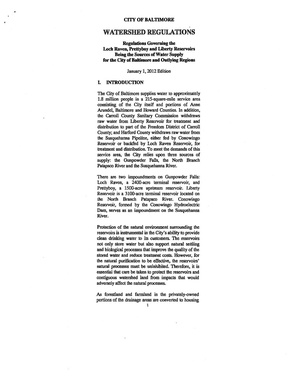Maryland/Baltimore Reservoir Watersheds
A page to streamline the tagging of Baltimore's reservoir watersheds.
Background
The Baltimore City Department of Public Works owns and maintains three large drinking water supply reservoirs for the Baltimore region. The reservoirs include, the Loch Raven Reservoir, the Liberty Reservoir, and the Prettyboy Reservoir. Each reservoir is surrounded by a larger watershed, a city-owned tract of primarily wooded lands to protect the water source. All of the watershed land is outside of the city and in adjacent counties.
Watershed Boundary
Each watershed is mapped at the parcel level, showing all of the public land.
- Loch Raven Reservoir Cooperative Wildlife Management Area
 Loch Raven Reservoir Cooperative Wildlife Management Area
Loch Raven Reservoir Cooperative Wildlife Management Area - Prettyboy Reservoir Watershed
 Prettyboy Reservoir Watershed
Prettyboy Reservoir Watershed - Liberty Reservoir Cooperative Wildlife Management Area
 Liberty Reservoir Cooperative Wildlife Management Area
Liberty Reservoir Cooperative Wildlife Management Area
Off-road Highway Classification
Each watershed is traversed by a network of city built and maintained unpaved roads. These roads are referred to as fire roads or woods roads and are built with the purpose of granting easy access to emergency responders in the event of a fire or major injury in the watershed. The roads (or tracks in OSM parlance), are typically wide enough for a 4x4 truck to travel on. Many of these roads follow the path of a former roadway or driveway that was closed when the reservoirs were constructed, once serving farms in the area. At the points where the fire roads intersect with the regular road network, there is typically a wire gate. Each gate is numbered with a sign for emergency responder coordination. The following is the accepted tagging of these fire roads: highway=track
Over the last 100+ years, hikers and mountain bikers have built trails off of and surrounding the fire roads for recreational purposes. These paths are typically singletrack, wide enough for one or two people walking side-by-side and are typically dirt surfaced. The paths should be tagged highway=path with appropriate surface and width tags.
Access

While the lands are publicly owned, unfenced, and have limited access controls, the land manager does impose certain restrictions in the name of protecting the water supply. Generally hiking, walking, trail running, and any other access on foot are allowed. However, the city has long opposed the use of its property and the trails within by mountain bikers. Mountain biking is only allowed on certain trails.

Access defaults
For designated mountain bike trails:
For user-built trails or fire roads where bikes are not allowed:
Historic Assets
Each watershed and reservoir were built on land that had previously been used for another purpose. The reservoirs were all built during the twentieth century. Prior to the construction of dams, the rivers at the base of the reservoirs supported industry and farmland uses. During the planning of the reservoirs, the city would typically buy the lands from owners, raze all structures, and burn/grub the fields and trees that would be underwater. However, the foundations were typically left in place, and no major terraforming was conducted. Many of these historic sites remain and are visible both on the ground, and sometimes using remote sensing imagery, such as LiDAR.
![]() ElliottPlack (on osm, edits, contrib, heatmap, chngset com.) conducted an exhaustive review of each reservoir using georeferenced, historic topographic maps as reference, to find and label all structures and points of interest in the now flooded or wooded towns and settlements. These items are typically tagged with
ElliottPlack (on osm, edits, contrib, heatmap, chngset com.) conducted an exhaustive review of each reservoir using georeferenced, historic topographic maps as reference, to find and label all structures and points of interest in the now flooded or wooded towns and settlements. These items are typically tagged with historic=ruins.